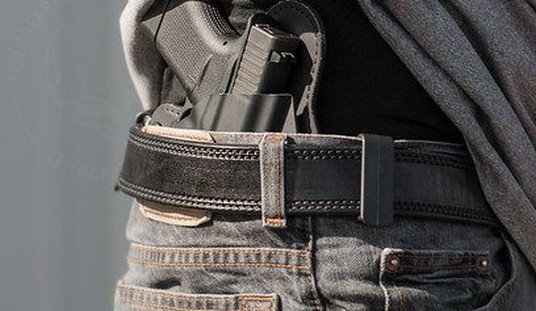A quick query on our Facebook page confirms what the recent NSSF MSR Report stated. There are a lot of new AR-15 owners out there, and many are interested in seeing a list of “must haves” for the platform… if only to have something to argue about.
The problem with compiling “must haves” is that the AR-15 is a platform with an endless number of combinations. There are .50 Beowulf personal defense weapons, lightweight .22 trainers, high-end designated marksman rifles, hunting rifles, and legitimate sniper rifles with a 1,200 yard reach, all based off of the basic AR platform.
For our purposes, we’re going to look at what most people are likely to have, which is a mid-range .223 Remington or 5.56 NATO chambered carbine with a 16″ barrel, a fixed front sight post, and either a cheap polymer folding rear sight, or no rear sight at all.
Here is a common example of this sort of basic carbine, offered by any one of a dozen or more manufacturers.
We;re going to be looking at this basic rifle, used in it’s most common role as a target range plinker from 0-300 yards, serving a secondary role as a self-defense weapon.
The very first thing you must know, without exception, is whether your rifle is chambered in .223 Remington or 5.56 NATO, or one of several hybrids chambers.
Despite the claims of keyboard commandos to the contrary, these chambers are not identical, and the 5.56 NATO round generates much higher chamber pressures. This can be dangerous, so do not fire 5.56 NATO rounds in a rifle chambered for .223 Remington. Read your owner’s manual, and if you do not have one, get one from the manufacturer. Fire only what they have designed the rifle to fire.
Now, on to the “must haves.”
The first and most obvious addition we need to make to the rifle above is the addition of a rear sight or optic. There are three basic choices to make.
- non-magnifying optics
- magnifying scopes
- iron sights
The “tacticool” trend these days seems to be towards red-dot or holographic sights. Of the red-dots, Aimpoint is the “king of the hill,” and the EOTech occupies the same place among holographics. Both are combat-proven optics systems, but they are expensive, and generally start around $400. They and their knock-offs are not a “must have.”
Most AR-15 with scopes are over-scoped, with 3×9 scopes originally designed for deer rifles being the most popular because they can be had cheap. If you’re going to scope an an AR carbine like our example, I’d recommend a mid-range 1×4-24mm on a good extended scope mount. Once again, though, once you buy a decent quality mount and scope, your’re looking at a baseline of at least $400 for something that isn’t a “must have.”
That’s a long way of getting to what I consider as a “must have” on an AR carbine, which is an American-made rear iron sight, which is going to run you between $100-200. Whether you chose an classic carry handle design, a modern fixed rear, or a high-quality folding metal rear is a matter of personal preference, but you’re going to put more shots on target accurately in the long run if you buy a quality iron sight and then use the rest of the money you would have spent for optics on ammunition and a foundational rifle marksmanship class.
The second “must have” for a basic carbine is a sling.
It is easy to get lost in endless discussions about the pros and cons of various sling types and techniques, but it really comes down to basics. There are slings that can be used to help you stabilize the rifle and therefore help you fire more accurately, and then there are slings that carry the rifle and keep it from hitting the dirt if you let go of it for one reason or another.
The best money you will ever spend on your rifle is purchasing an G.I. web sling, often referred to as a loop sling or M1 Garand sling. An American-made G.I. sling with good hardware is going to cost you a whopping $10-$20, and will fit the sling loops on the front and rear of the basic carbine pictured. There are both cotton and nylon variants. I prefer the cotton as it tends to slip less than a nylon sling, but it will stretch a little more when wet. If you find a good foundational rifle marksmanship class (I’ve mentioned that twice now, consider it a hint), they can teach you how to use this simple sling in loop, hasty, and hasty-hasty configurations to help steady your rifle and fire more accurate shots.
The single point sling is all the rage today and variants can cost serious money, but it basically serves to keep your rifle out of the dirt, and out of the way, and I’ve not seen it used as an accuracy aid. It is however, very popular in tactical training, so to each his own.
The next “must have” for an AR-15 is a supply of good magazines, and I can’t imagine having less than four, personally. Any GI-spec aluminum magazine will do, and I have a personal fondness for PMags and Lancers. Keep mind mind magazines are consumables; once they become unreliable, throw them away and buy more.
The modern standard capacity for the AR-15 is a 30-round magazine. That is the standard capacity magazine used by the military and is therefore emulated by many civilians, and if firepower is a concern for you, then by all means, use them.
In my personal experience, however, I’ve noticed that 20-round magazines are more practical if you spend much of your time firing from a bench at the range or prone positions, and depending on your individual body geometry and sling use, this can hold true for standing and sitting positions as well. I’ve found that my collection of 30-round magazines spend most of their time in the gun safe, while my 20-rounders live in my range bag. If you live in capacity-restricted states, I’m afraid your choice has been made for you.
And that’s it!
Anything beyond a quality rear sight, G.I. sling, good magazines, the right ammo for your rifle and good foundational training is a “nice to have.”
What are some of the more useful “nice to haves?”
That’s another post, for another day.









Join the conversation as a VIP Member